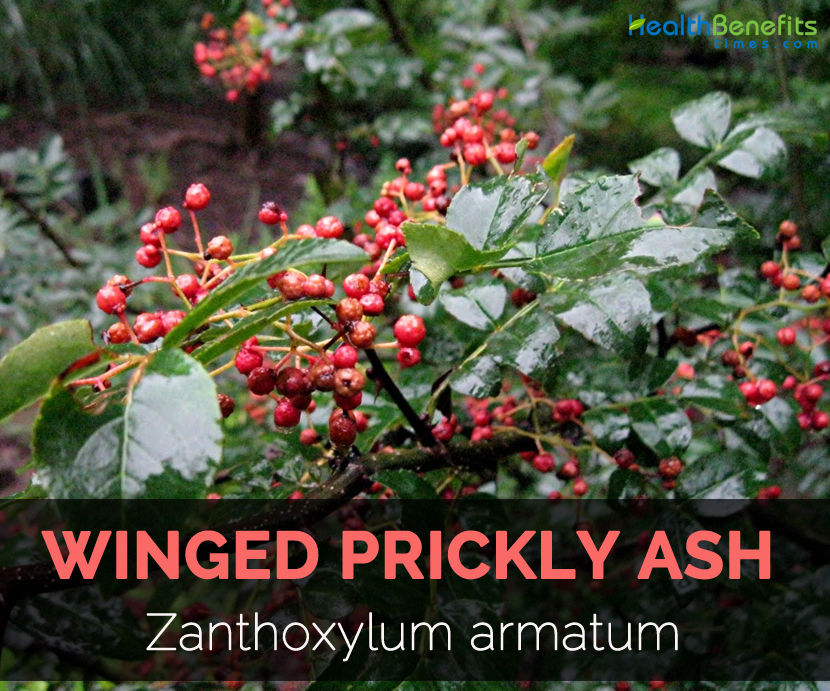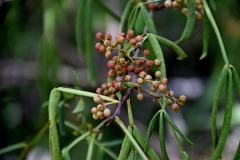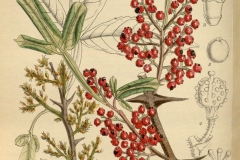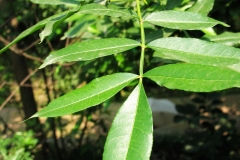It is a large spiny shrub or small tree. Leaves are trifoliate with leaf stalk winged. Leaflets are stalk less, elliptic to ovate-lace like, 2.0-7.5 × 1.0-1.7 cm, entire to slightly toothed, sharp-tipped and base sometimes oblique. Flowers are minute, yellow that form in leaf axils. Flowers have 6 to 8 acute sepals. Petals are absent. Female flowers have 1 to 3 celled ovary, pale red and 3 mm in diameter. Male flowers have 6 to 8 stamens and large anthers as the flowers look yellow. Seeds are shining black, round and 3 mm in diameter. Flowering period starts from March to April.
Distribution
It is found in hot valleys of subtropical to temperate Himalayas, Laos Myanmar, Laos, north-east India and Pakistan, Bhutan, Bangladesh, china, North & South Korea, Japan, Taiwan, North Vietnam, Philippines, Lesser Sunda Islands and Sumatra. In the context of Nepal, it is distributed from west to east at an elevation range of 1000 to 2500 meters in open places and in forest undergrowth. The plant develops in open pastures, wastelands and secondary scrub forest with adequate rainfall. Its habitat is moist areas with deep soils exposed to sun and degraded slopes, natural forests, shrub lands and wastelands. It is found in hot valleys of subtropical Himalayas from Indus area to Bhutan.
Plant
The small aromatic tree is 6 meters high with glabrous branches usually armed with straight or slightly compressed and reddish brown stipular spines. Leaves are imparipinnate having 3 to 5 pairs of leaflets, acuminate, elliptic-lanceolate, sessile, rounded or cuneate, margins are usually entire. Inflorescences are terminal panicles that form on short lateral shoots. Flowers are polygamous, minute that form on short cymes. Flowers have 6 to 8 stamens, 2 mm filaments arranged around globose pistillode. A small drupe is a reddish, ovoid and glandular warted and splits into two when ripe. Fruits have single seed which is rounded, black and about 2-3 mm size.
Floral characteristics
Flowers form in dense terminal or sparse axillary panicles. It is green to yellow. Calyx comprises of six to eight sub-acute lobes. Stamens are six to eight. Follicles or ripe carpels are solitary, tubercled and pale red. The plant blooms flowers from March to May.
Traditional uses
- Bark and seeds are used as a tonic for treating dyspepsia, fevers and cholera.
- Branches, fruits and thorns are carminative and stomachic. It is used as a cure for toothache.
- Take the seeds with warm water to treat stomach problems.
- Seeds and fruits are used to cure cholera, toothache and to repel leech.
- Fruits are used as a tonic for cold, fever, indigestion and cough.
- Chew the seeds to cure toothache.
- In Nepal, fruit decoction and berries are used for rheumatism, abdominal pain, cholera, skin diseases, asthma and diabetes.
- Use the fresh fruits as spices or making pickles.
- Fruit extracts are used to expel round worms.
- Use the fruits in dental problems and its lotion are used for scabies.
- In China and India, it is used as a remedy for snake bites.
- Bark, seeds and fruits are used as aromatic tonic for fever and dyspepsia.
- Tender twigs are used as a remedy for toothache and to brush teeth.
- It is used in various chronic problems such as skin diseases, rheumatism, leg cramps and ulcers.
- It is used for fever, low blood pressure and inflammation.
- Use poultice (lukewarm) of fresh leaves with rice flour to lower excessive inflammation and pain in neck and throat.
- Use bark decoction (cold) to clean wounds and ulcers.
- Leaves infusion is used to provide relieve stomach pains.
- Apply the leaves paste externally for treating leucoderma.
- Bark tincture or tea is used for treating dyspepsia, rheumatism, heart and kidney problems and dysentery.
- Tea prepared from inner bark is used for treating itchy skin.
Culinary uses
- Ground the seeds into powder and use it as condiment.
- Use young leaves as a condiment.
Precautions
- It is better to consult the health practitioner before treating any health conditions.
- If experienced any allergic reactions, avoid its use.
References:
https://pfaf.org/user/Plant.aspx?LatinName=Zanthoxylum+alatum
https://echarak.in/echarak/templates/Zanthoxylum%20%20armatum%20%20%20DC..pdf
https://en.wikipedia.org/wiki/Zanthoxylum_armatum
http://www.flowersofindia.net/catalog/slides/Winged%20Prickly%20Ash.html
https://wikiwel.com/wikihealing/index.php?title=Winged_Prickly_Ash
https://pfaf.org/user/Plant.aspx?LatinName=Zanthoxylum+americanum
Comments
comments
| Winged prickly ash Quick Facts | |
|---|---|
| Name: | Winged prickly ash |
| Scientific Name: | Zanthoxylum armatum |
| Colors | Red |
| Shapes | Subglobose, 4-5 mm in diameter |
| Taste | Bitter |



